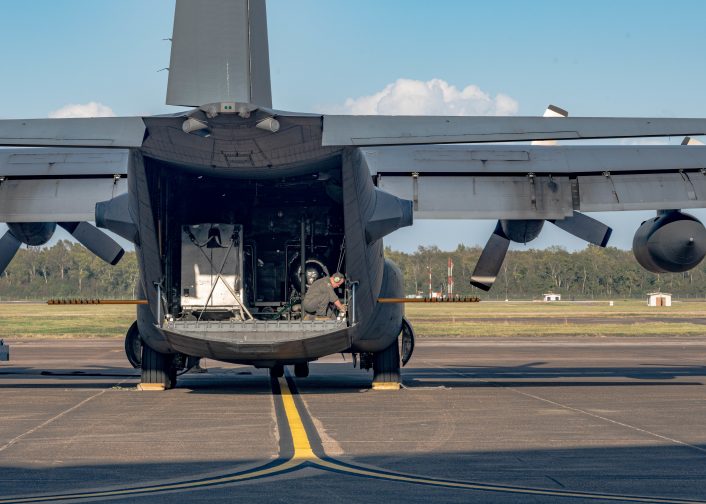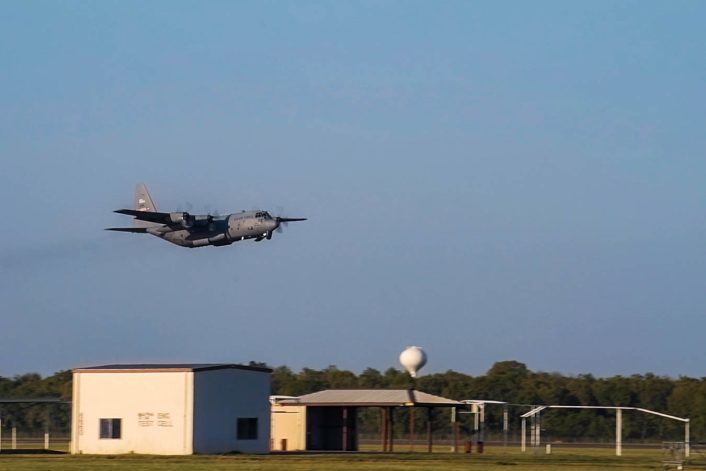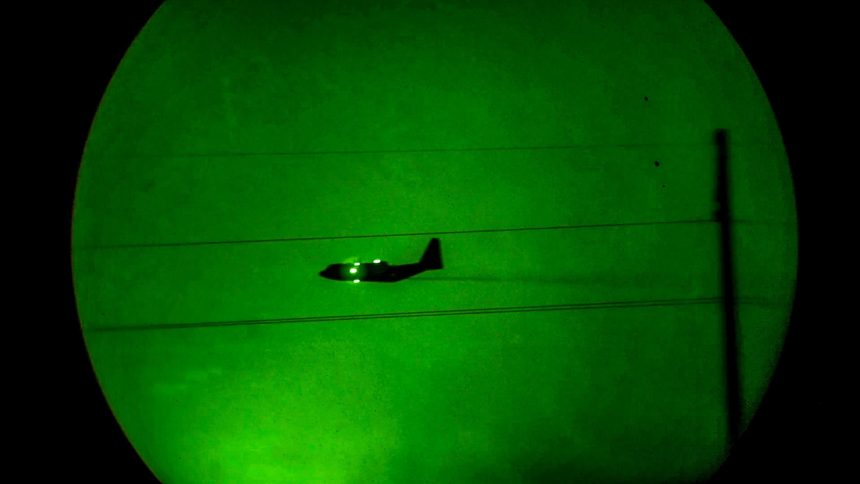C-130H Hercules aircraft of the 910th Airlift Wing, based at Youngstown Air Reserve Station, Ohio, carry out mosquito control missions.
The 910th AW (Airlift Wing) based at Youngstown Air Reserve Station, Ohio, is the only aerial spray capability and dedicated aerial spray maintenance flight of the Department of Defense.
The unit operates C-130H Hercules aircraft, equipped with specially-designed Modular Aerial Spray Systems (MASS) that are used to carry out the aerial spray mission, that has been common practice since 1973 and involves spraying for disease-carrying pests over Department of Defense (DoD) installations and anti-foliage operations on bombing ranges to decrease inadvertent brush fires and to expose unexploded ordnance (UXO) after bombings. The U.S. Air Force program also maintains a stand-by readiness capability using oil dispersing agents to neutralize openwater oil spills, and vector control over metropolitan areas after a natural disaster.
Last but not least the 910th AW conduct mosquito control aerial spray missions across the U.S. as it has happened starting last week, when the unit along with 85 Reserve Citizen Airmen deployed to Barksdale AFB, Louisiana to fly over southern Louisiana and assist civil authorities fighting pest insects. For these missions, Environmental Protection Agency (EPA) registered materials are used and the MASS disperses no more than one ounce of product per acre.
Noteworthy, there are three Special Mission C-130 units in the Air Force: the 53rd Weather Reconnaissance Squadron (WRS), 403rd Airlift Wing, Keesler Air Force Base, Mississippi. “Hurricane Hunters”,
As explained in an official public release, at the request of the Federal Emergency Management Agency, and upon approval by the Department of Defense, U.S. Northern Command activated the 910th AW to provide aerial spray capability in the areas where the heavy rains from the recent hurricanes have resulted increasing number of mosquitoes, which can spread disease and also hinder recovery workers, resulting in less time in the field.
The 910th AW C-130s have been spraying Lousiana since Oct. 20, 2020, and have treated nearly half a million acres as of Oct. 25, 2020. According to the Governor’s Office of Homeland Security and Emergency Preparedness, the C-130s are scheduled to spray in Acadia, Calcasieu, Cameron, Iberia, Jeff Davis, Lafayette and Vermilion parishes.
The last time the 910th AW supported FEMA hurricane recovery efforts with its aerial spray mission was 2017 when they treated 2.7 million acres of affected areas following Hurricane Harvey.
“Our military men and women are privileged to be able to assist the interagency team and people of Louisiana as they recover from the recent hurricanes Delta and Laura,” said Lt. Gen. Kirk Pierce, commander, First Air Force, Air Forces Northern.

Specialized C-130Hs
While the Air Force Reserve Command has the goal to modernize the capability with the procurement of 10x C-130J models, since 1986, the Air Force has employed the C-130H aircraft in spray missions, and currently uses six specially modified C-130H2 airframes.
According to a research titled “U.S. AIR FORCE’S AERIAL SPRAY MISSION: SHOULD THE DEPARTMENT OF DEFENSE CONTINUE TO OPERATE THIS WEAPON OF MASS DISPERSION?” submitted to the Air University of the Air Command and Staff College by U.S. Air Force Reserve Maj. Scott J. Julian the process of specializing a C-130 for spray “involves affixing a specially built spray boom that connects from the MASS on the interior of the aircraft through a two-inch hole in the aft hatch doors on each side. The booms extend six feet out of the aft doors with 2 – 30 individual spray nozzles each, depending on the
agent being dispersed. All modifications to the C-130 to make it a special-mission aircraft are accomplished at the 910th Maintenance Squadron’s (910 MXS) Aerial Spray Flight (ASF), 910th Maintenance Group (910 MXG), 910 AW by spray-dedicated maintainers.”
“To conduct aerial spray missions at low altitudes, specialized liquid containers were developed to fit specifically into a C-130; this system is called the Modular Aerial Spray System (MASS). There are six types of MASS altogether: one is used exclusively for training with water, two are ultra-low volume systems and three are what is known as a normal system, each 6 with four-500 gallon main tanks and a 250 gallon flush tank. The ultra-low volume system
(ULV) is used specifically for aerial pesticide dissemination because of the relatively small amount of product needed to spray for nuisance insects over a vast area.
The ULV system is attached to a boom with eight to 30 nozzles on each side, depending on the entomologist’s specifications; it delivers .03 gallons of fine-mist pesticide per minute. Applications that require massive amounts of liquid herbicide to neutralize cheatgrass and other fire-prone, invasive vegetation on bombing ranges will use the normal spray system. Cheatgrass is an invasive, nonnative grass that rapidly spreads in agricultural producing farm fields throughout the United States; it can reduce some crop yields by 33%. Oil dispersing missions will also use the normal system due to the large amount of dissolving agent required to neutralize a crude oil slick over an open body of water. The normal system is attached to a boom with only two larger bell nozzles that will deliver up to 300 gallons per minute.
The MASS is designed to fit only one system per aircraft. The spray system is loaded onto a C-130 using another specially-developed, 20-wheeled vehicle known as a 60K Tunner loader, or K-Loader. The MASS rests on hundreds of rollers on the K-Loader and is then slowly rolled onto the aircraft by spray maintainers and C-130 loadmasters, taking about one-hour until it is in place. The MASS consists of four interconnected tanks with three pumps per module (15 horsepower for herbicide and 5 for pesticide) which is operated by a specially-trained load master from an analog control panel on the forward of the MASS. The current system is over 20 years old and ASF maintainers claim the MASS is in need of a replacement due to aging technology, inefficient pump rates, and severe internal corrosion. The 910 AW is currently working with local congressional representatives to procure new MASS equipment to meet
future spray demands,” Maj. Scott J. Julian says in his research.
Special aircrews
Interestingly, the C-130 aircrews include pilots, flight engineers, navigators and loadmasters who also double as aerial spray operators and an entomologist. Ground support personnel for the mission include additional entomologists, operations support mission planners, aerial spray maintenance, communications, aircraft maintenance, squadron aviation resource managers, aircrew flight equipment and a command team including a mission commander, director of operations, a mission first sergeant and public affairs representatives.

“Because of its unique capability, specialized personnel must also be employed to operate the spray program. Twelve aerial spray maintainers make up the ASF, including seven full-time Air Reserve Technicians (ART) and five Traditional Reservists (TR). All ASF personnel must first advance through the MXS in a primary Air Force Specialty Code (AFSC) before they can become a spray maintainer. These members are responsible for the development, maintenance, and repair of everything associated with the MASS, including the spray boom and nozzle elements, pump, and inner mechanics of the system.
MASS parts are fabricated and fitted internally at the 910 MXS. Two ART and two TR entomologists are also employed at the 910 AW. Entomologists work with the Environmental Protection Agency (EPA) and collaborate with the USDA Center for Medical and Veterinary Entomology (CMAVE) to develop and conduct pest control methods using military aerial assets. 910 AW entomologists are responsible for research and investigation of pest insects that carry vector-borne diseases, and the most effective ways of eliminating them in particular areas of the United States.
Five specially trained aircrew make up the flying segment of the spray program: a pilot, co-pilot, navigator, flight engineer, and a loadmaster. These spray aircrew operate out of the 757th Airlift Squadron (757 AS), 910th Operations Group (910 OG), 910 AW. Aircrew must maintain currency specific to this special mission in addition to their regular tactical airlift and airdrop currencies. Aircrew may soon have the ability to operate the spray mission 24-hours per day. In September 2013 the 757 AS was directed by AFRC to develop a night time aerial spray program, utilizing night vision goggles (NVG), to specifically target vector-borne carrying pests that operate mainly at night.”
Indeed, the AFRC 910th Aerial Spray Flight normally conducts spray missions at dusk and nighttime hours using NVGs when pest insects are most active. The aerial spray applications are usually performed at very low altitudes, so that the insect and herbicide are effectively delivered where is needed and to avoid spray drift. Insect and herbicide treatments are dispensed at 150 feet above ground level (AGL) while oil dispersant application is accomplished at 300 – 500 feet AGL. “A C-130 spray sortie consists of a standard back-and-forth pattern across the area to be covered, utilizing visual flight rules (VFR), or aerial dead-reckoning, and the blue-colored dye as reference points,”









